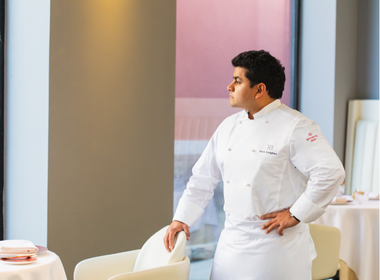
Lucas Garigliano: his journey of excellence
Through the dynamic community of 11,000 alumni gathered on the Hosco platform, discover the inspiring journey of Lucas Garigliano.
As has been the case for the past 3 years, Le Cordon Bleu Paris has once again given a seminar on pairing food and sake from the province of Hiroshima in the presence of sake specialist, Sylvain Huet, and the Institute’s Wine Department Manager, Franck Ramage.
This seminar aims to provide participants with an introduction to sake, with a particular focus on Hiroshima sake.
On Tuesday 22 November 2016, Restaurant Management and Culinary Arts students had the opportunity to taste 9 sakes from Hiroshima paired with 9 dishes, created and prepared by Chefs Eric Briffard, One of the Best Craftsmen in France (Meilleur Ouvrier de France - MOF), and Alexandra Didier.
Sakes |
Dishes |
|---|---|
| Fujii Shuzou served in glass at cool temperature - Ryusei "Shiro" Junmai Ginjo Miyake Honten served in kikichokos at 45°C - Sempuku “Shinriki” Kimoto Junmai Muroka Genshu 85 Suishin Yamane Honten served in glass at cool temperature - Suishin Cho-Nansui-jikomi Junmai Ginjo Umeda Shuzojo served in glass at cool temperature - Honshuichi Muroka Junmai Ginjo Enoki Shuzo served in glass at room temperature - Hanahato Kijoshu Hachinen Chozo Kamoizumi Shuzo served in kikichokos at 35°C - Kamoizumi “Zoka” Junmaishu Morikawa Shuzo served in glass at cool temperature - Hakukou “Sara” Junmai Daiginjo Kamotsuru Shuzo served in kikichokos at 30°C - Kamotsuru Junmai Ginjo Itteki Nyukon Chugoku Jyozo served in glass at cool temperature - Ichidai "Aimisen" Daiginjo |
’Spéciales’’ oysters with finger lime lemon and yuzu Grilled cuttlefish, cooked and raw cauliflower with botargo Scallops with lemongrass, butternut purée with hazelnut Salma salmon, Granny Smith apple, Crémona mustard fruit Chicken broth flavoured with lemongrass and raw foie gras Chicken thigh sautéed with saté, onion, leek, cucumber, pineapple Laquered octopus, fondant mooli, horseradish tofu Saké leavaned bread (Sakekasu), served with fresh ewe’s milk curds Lychee granita with raspberries |
In general, Saijo in Hiroshima, Nada in Hyogo, Fushimi in Kyoto are considered the 3 best known brewing locations in Japan. This relates to their high concentration of breweries around abundant high quality water, amongst other factors including rice, climate and logistics. These regions have all played an important historical role in the development of sake.
Sake is however produced all over Japan, from the most northern prefecture of Hokkaido to the most southern prefecture of Okinawa.
Complex, highly aromatic sakes such as daiginjos can often be enjoyed as an aperitif, while koshu, which has some earthiness or aged aroma, can make a good after dinner drink. However, sake has always been associated with food. As a matter of fact, its chemical composition (amino acids such as glutamic acid, succinic acid and many other organic acids), absence of tannin and lower acidity than wine make it more versatile and easier to associate not only with Japanese food, but to Western flavours as well. Sake is much less overbearing than wine, and in particular red wine, and is renowned for enhancing the umami in food.
Copyright © 2025 Le Cordon Bleu International B.V. All Rights Reserved.